In 1929, Al Capone was worth an inflation adjusted 1.5 Billion Dollars.
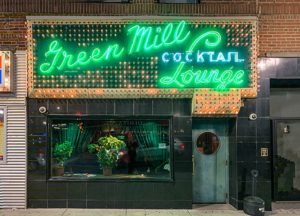
Most speakeasies and night clubs serving illicit alcohol provided entertainment in some form, mostly jazz or a vocalist with a band. One of these entertainers named Joe E. Lewis was a regular performer at the Green Mill, a club that was owned by the Outfit. As compensation, Al Capone gave Jack McGurn a piece of the club’s profits and when McGurn found out that Lewis was not going to renew his contract and was going to earn more money at the Rendezvous, a North Side Gang operation, he confronted the singer-comedian and told him he couldn’t leave.
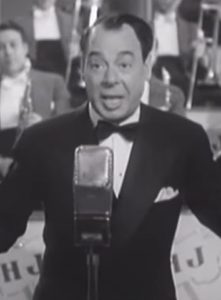
Lewis brushed him off, said his contract was up and that was that. He actually performed at the Rendezvous for a week, protected by a bodyguard who accompanied him to and from his hotel residence. Lewis then decided he didn’t need protection, that McGurn had only been trying to scare him. On November 9, 1927, seven days after he opened at his new club, three men showed up at Lewis’ Commonwealth Hotel room, burst in on the sleepy Lewis when he opened the door and pistol whipped him into unconsciousness. Then one assailant took a large knife to Lewis’ throat and mouth and even cut off part of the singer’s tongue. Although they could have merely shot the defiant entertainer, the thugs instead sent a terrible message to Lewis and any other performer who attempted to assert such independence. Joe E. Lewis managed to crawl into the hallway and was quickly taken to a hospital where he underwent extensive but successful surgery. He recovered but eventually became a stand-up comedian, his voice now a bullfrog like croak, no longer able to belt out night club standards. Ironically, most likely to counter the public outcry over the incident, Al Capone actually went out of his way to patch things up, claiming to Lewis personally that he knew nothing about the attack and that Joe should have come to him personally if he had a problem. Capone also got him back to the Green Mill, equaling his deal at the Rendezvous, and gave Lewis winning tips at dog and horse races controlled by the Outfit. Lewis’ career continued successfully well into the sixties, and a biographical film starring Frank Sinatra called the Joker Is Wild was produced in 1957, reiterating Lewis’ terrible ordeal and recovery.
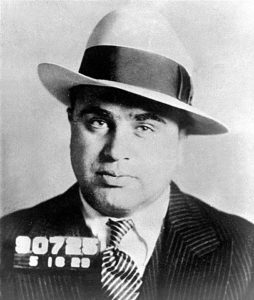
While this investigation proceeded laboriously, in mid-1929, a curious incident occurred which only added to the mysterious lore surrounding Al Capone. In mid-May of 1929, Capone traveled to Atlantic City to participate in what became known as the Atlantic City Conference. Organized by Meyer Lansky, this gathering included almost all of American organized crime including Capone, Lucky Luciano, Frank Costello and many other gangsters from all over the US. The meeting was the first attempt by the American underworld to set up a national organization to oversee and make decisions to divide territory and adjudicate disputes without violence. Another underlying issue was a resolve to minimize the attention that Al Capone was generating, involving both the type of violence that occurred with the St. Valentines Day Massacre and Capone himself, who routinely sought out positive media coverage and made himself publicly prominent to the point of celebrity, behavior that created hostility from other prominent underworld figures who abhorred attention of any kind. Following the conference, which concluded on May 16, Capone intended to return to Chicago by train via Philadelphia. With some time on his hands, he and a bodyguard went to a movie and when the film ended, upon leaving the theater, both men were arrested, searched and found in possession of a firearm, in Capone’s case a .38 caliber revolver.
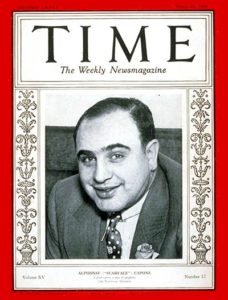
. But his respite was brief, In late April, the Chicago Crime Commission, a watch-dog collection of businessmen with no legal standing issued a list of the 14 most prominent Public enemies in the city. Headlines about this list screamed over the front pages of every American newspaper and when Capone attempted to lie low in Miami, he was continually arrested there as a public nuisance, harassment that he eventually successfully fought in court.
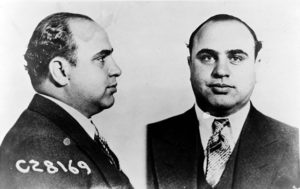
Al Capone’s legal good fortune ran out on October 18 when the jury returned with a verdict of guilty. Six days later Capone received a sentence of eleven years, the longest sentence ever imposed for tax evasion. By comparison, Nitti and Guzik received 18 months and five years respectively. Although he would appeal, Capone was confined in the Cook County Jail until May 2, 1932, when the Supreme Court of the United States refused to hear his case. Immediately, the Federal government prepared to send him not to Leavenworth , where Nitti and Guzik languished, but to the penitentiary in Atlanta, the system’s harshest. He began serving his sentence on May 4.
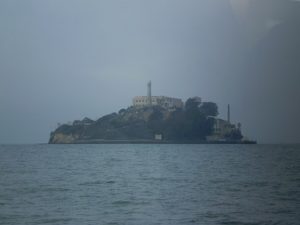
On August 19, 1934 Al Capone was placed on another train with 42 other prisoners, a train that was very different from his ride to Atlanta on the Dixie Flyer where he interacted with other civilians and played cards. It was armored with bulletproof plating, its windows barred, the Atlanta prison warden and numerous heavily armed guards along for the ride. The occupants were not told of their destination, but rumors had swirled for months about a new federal prison, even harsher than Atlanta, an escape proof dungeon on an island in San Francisco Bay. It was called Alcatraz.
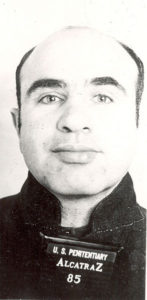
Because of his notoriety, his propensity for braggadocio about past criminal exploits and his constant demands from the warden for special treatment, Al Capone was not a popular inmate. In fact, on June 26, 1936, another inmate stabbed him with the detachable blade of a pair of barber shears, which Capone survived.
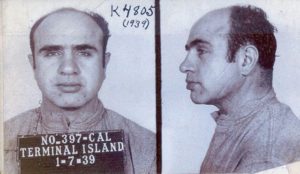
Finally, unwillingly to merely release Capone before his time, the Bureau of Prisons allowed his transfer to Terminal Island, in San Pedro, California on January 6, 1939. By now, Capone’s mental capacity was utterly diminished, his conversation peppered with the mention of celebrities. exploits and future plans that were utterly delusional. Neither the Capone family or the Federal government wanted the spectacle of a public release of Al Capone. Government doctors recommended that the family consign Capone to the care of members of the medical staff at Johns Hopkins Hospital in Baltimore, the leading specialists in the nation on the treatment of neurosyphilis. Capone was secretly transferred to the penitentiary at Lewisburg, PA and then officially released on November 16, 1939.
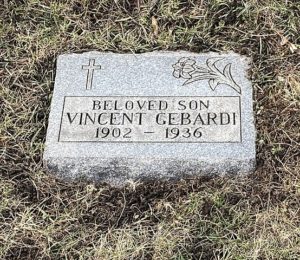
It took longer, but the demise of Jack McGurn was perhaps the most illustrative example of how quickly Capone’s power diminished. McGurn was always considered a braggart and a hothead, and with Capone gone, Frank Nitti had no use for him, McGurn too recognizable as a hitman. For a while McGurn tried to hustle a living as a golf pro, hanging out at a mobbed up Chicago golf course of which he was a part owner. By 1936, still married to Louise Rolfe, McGurn was broke, hadn’t killed anyone in years and was rumored to have threatened Frank Nitti if Capone’s successor didn’t let him back into the rackets. On February 14, 1936, seven years to the day after the infamous massacre he allegedly planned, Jack McGurn was bowling with two buddies, a regular Friday night outing. Shortly after midnight, three gunmen burst into the bowling alley and methodically shot him fatally in the head and back. Although technically, February 15, earlier on Valentine’s Day, someone knowing that McGurn would be at the bowling alley, left him an inscribed Valentine with a drawing of a couple, apparently in need of cash, standing gloomily with a For Sale sign next to their worldly goods. The printed message inside read:
“You’ve lost your job; you’ve lost your dough;
Your jewels and cars and handsome houses!
But things could still be worse, you know…
At least you haven’t lost your trousas!”
Podcast: Play in new window | Download
Subscribe: RSS
